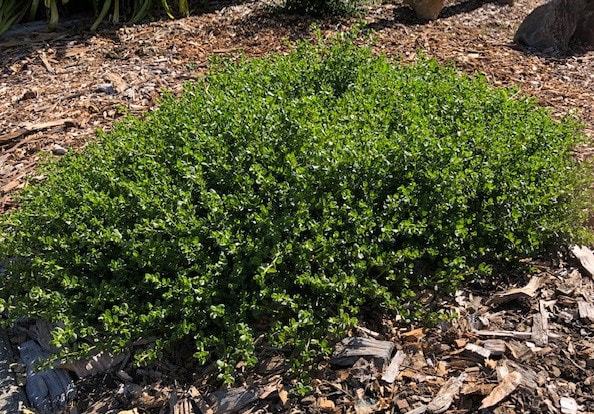Baccharis pilularis 'Pigeon Point': A Coastal Marvel

In the coastal regions of California, Baccharis pilularis 'Pigeon Point' stands as a testament to the resilience and beauty of native plants.
With its dense foliage and tolerance for a variety of environmental conditions, this cultivar of the coyote brush species adds texture and character to coastal landscapes, while also providing valuable habitat and forage for wildlife.
In this comprehensive article, we'll explore the various aspects of Baccharis pilularis 'Pigeon Point', from its botanical description to its ecological significance and conservation status.
Botanical Description
Baccharis pilularis 'Pigeon Point' is a cultivar of the Baccharis pilularis species, commonly known as coyote brush or chaparral broom.
It is a perennial evergreen shrub that typically grows to a height of 3 to 6 feet (0.9 to 1.8 meters) and spreads vigorously to form dense thickets.
The foliage consists of small, narrow leaves that are arranged alternately along the stems.
Inconspicuous flowers appear in late summer to early fall, producing fluffy seed heads that persist through the winter months.
'Pigeon Point' stands out for its compact growth and dense, rounded shape, making it perfect for projects focused on erosion control and slope stabilization.
Habitat and Distribution
Baccharis pilularis 'Pigeon Point' originates from California's coastal areas, thriving in diverse habitats like bluffs, dunes, and scrublands.
Adaptable to well-drained soils, salt spray, and winds, it's ideal for coastal gardens.
Named after Pigeon Point, a landmark on California's coast, it's frequently encountered growing naturally in the wild.
Life Cycle and Phenology
As a perennial shrub, Baccharis pilularis 'Pigeon Point' has a relatively long life cycle.
It typically begins growing in late winter to early spring, producing new foliage and stems as temperatures warm.
Flowering occurs in late summer to early fall, when small, inconspicuous flowers appear along the branches.
These flowers are pollinated by a variety of insects, including bees and butterflies, which are attracted to the nectar and pollen.
Following pollination, the plant produces fluffy seed heads that are dispersed by wind, helping to colonize new areas and establish dense thickets.
Ecological and Cultural Importance
Baccharis pilularis 'Pigeon Point' plays a crucial role in coastal ecosystems as a primary producer and habitat provider.
Its dense foliage offers shelter and nesting spots for birds and small mammals, while its blooms draw pollinators and beneficial insects.
Moreover, the deep roots of 'Pigeon Point' aid in stabilizing coastal soils, vital for conservation efforts.
Historically, indigenous communities utilized coyote brush for basketry, medicine, and ceremonial practices, underscoring its cultural importance in Native American traditions.
Conservation and Threats
While Baccharis pilularis 'Pigeon Point' is not currently listed as threatened or endangered, habitat loss and fragmentation pose significant threats to wild populations of coyote brush throughout its range.
Urban development, agriculture, and invasive species encroachment all contribute to the decline of coastal habitats where 'Pigeon Point' is found.
Conservation efforts focused on habitat restoration, invasive species control, and land preservation are essential for ensuring the long-term survival of this important species and its associated ecosystems.
Caring for Baccharis pilularis 'Pigeon Point'
Sunlight
Plant 'Pigeon Point' in a location that receives full sunlight to partial shade.
While it can tolerate some shade, it will produce the most vigorous growth and dense foliage in full sun.
Soil
This plant prefers well-drained, sandy or loamy soil with a slightly acidic to neutral pH.
Amend heavy clay or compacted soil with organic matter such as compost to improve drainage and fertility.
Watering
Once established, Baccharis pilularis 'Pigeon Point' is drought-tolerant and requires minimal supplemental watering.
Water deeply but infrequently, allowing the soil to dry out slightly between waterings.
Avoid overwatering, as this can lead to root rot and other issues.
Mulching
Apply a layer of organic mulch, such as shredded bark or wood chips, around the base of the plant to help retain soil moisture and suppress weed growth.
Keep the mulch pulled back several inches from the stems to prevent rot.
Pruning
Minimal pruning is required for Baccharis pilularis 'Pigeon Point'.
Remove any dead, diseased, or damaged growth as needed, and lightly shape the plant to maintain its desired form.
Avoid heavy pruning, as this can detract from the plant's natural form and reduce its habitat value.
Fertilization
'Pigeon Point' generally does not require fertilization if grown in healthy soil.
However, if necessary, apply a balanced, all-purpose fertilizer sparingly in spring, following the manufacturer's recommendations.
By adhering to these care instructions, you can nurture thriving Baccharis pilularis 'Pigeon Point' in your garden or landscape, enriching coastal beauty and wildlife habitats.
Remember that whether for erosion control, slope stabilization, or ornamental purposes, this adaptable shrub exudes resilience and ecological significance.
Leave a Reply
You must be logged in to post a comment.